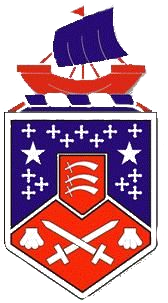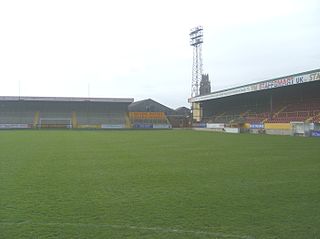
Tannadice Park, usually referred to as Tannadice, is a football stadium in Dundee, Scotland. It is the home ground of Dundee United F.C., who have played at Tannadice since the club was founded as Dundee Hibernian in 1909. The stadium has been all-seated since 1994 and has a capacity of 14,223. It is located only 200 yards from Dundee F.C.'s stadium, Dens Park; the two are the closest senior football grounds in the UK.

Firhill Stadium is a football and former rugby union, rugby league and greyhound racing stadium located in the Maryhill area of Glasgow, Scotland which has been the home of Partick Thistle since 1909. The stadium is commonly referred to as simply Firhill, although between September 2017 and September 2020 it was also known as The Energy Check Stadium at Firhill for sponsorship reasons.

The Ryan McBride Brandywell Stadium is a municipal football stadium with an adjoining greyhound racing track in Derry, Northern Ireland. It is the home ground of League of Ireland team Derry City F.C. and (temporarily) NIFL Premiership team Institute

Eastville Stadium, also known as Bristol Stadium and Bristol Stadium – Eastville, was a stadium in Eastville, a northern suburb of the English city of Bristol.
Brockville Park was a football stadium located on Hope Street in Falkirk, Scotland, 0.25 miles (0.4 km) north-west of the town centre. It was the home of Falkirk F.C. from 1885 until the end of 2002–03 Scottish football season. The record attendance at Brockville Park was 23,100 on 21 February 1953 in a match against Celtic. The stadium has since been replaced with a Morrisons supermarket. An old turnstile is on display next to the supermarket's car park.

Jenner Park is the premier sports stadium in Barry, Vale of Glamorgan, Wales and traditional home of football club, Barry Town United.

F.C. Clacton is a football club based in Clacton-on-Sea, Essex, England. The club are currently members of the Essex Senior League and play at the Rush Green Bowl.

York Street, also known as The Jakemans Stadium for sponsorship purposes, is a football stadium in Boston, England, and was the former home of Boston United. Originally called Shodfriars Lane, football was first played on the site since the late 19th century by a variety of Boston teams, but it was only used by Boston United since 1933. In the late 1970s the ground was rebuilt. Although the ground currently had a maximum capacity of 6,643, the record crowd was 11,000 against Derby County. 10 further attendances of more than 8,000 are on record. Boston United left the York Street ground at the end of the 2019/20 season. In August 2021 Railway Athletic FC moved into the stadium.

Arden Street Oval is a sports oval in North Melbourne, Victoria. It is currently the training base of the North Melbourne Football Club, an Australian rules football club, and up to the end of the 1985 season it was used as the team's home ground for Victorian Football League (VFL) matches.

New Grosvenor Stadium and Drumbo Park is a multi-purpose stadium in Ballyskeagh, County Down, Northern Ireland. It is currently used for football matches and greyhound racing, the latter is operating under the name Drumbo Park. The stadium currently has a total capacity of 1,500 which 790 can be seated, however this is split to a capacity for football matches of 1,500 and a capacity of 1,000 for greyhound racing.
The City Ground was a football stadium and greyhound racing track, in Cambridge, England. It was the home of Southern League Premier Division club Cambridge City F.C.

Central Park is a multi-use stadium in Cowdenbeath, Fife, Scotland, used for football and stock car racing. It is situated in the centre of the town, just off the High Street, and has a capacity of 4,309. The pitch size is 107 x 66 yards. Central Park has been the home ground of Lowland League team Cowdenbeath F.C. since it opened in 1917. Stock car racing has taken place at the ground since 1970, and takes place on a tarmac racetrack surrounding the football pitch. Central Park was also previously a venue for greyhound racing between 1928 and 1965.
The Seedhill Football Ground was a football stadium in Nelson, Lancashire. It was the home of various incarnations of current North West Counties League Division One side Nelson F.C. from 1889, when the Burnley Express reported an opening senior fixture played against Burnley on March 16th 1889, until 1971. During their tenure at Seedhill, Nelson were members of the English Football League between 1921 and 1931. Nelson's last game at Seedhill was a Lancashire Combination fixture on Sunday 28 March 1971 against local rivals, Clitheroe F.C. Local newspaper, the Nelson Leader, reported that a crowd of over a thousand gathered to see Clitheroe beaten by five goals to three in what was not only the last game but also the first Sunday game at the stadium. Nelson then moved to their current Victoria Park ground on Lomeshaye Holme for the start of the 1971–72 season. Seedhill football ground was demolished in the early 1980s to make way for the M65 motorway.
Redheugh Park was a football stadium in Gateshead, England. The stadium was built in 1930 when South Shields F.C. moved to Gateshead from Horsley Hill and became Gateshead AFC. It was their home for more than 40 years.
Cressing Road, also known as the Dunmow Group Stadium for sponsorship purposes, is a football stadium in Braintree, Essex, and the home ground of Braintree Town, and formally their reserve side. It currently has a capacity of 4,151.
Southend Stadium was a former greyhound racing and football stadium in Grainger Road, Southend-on-Sea, Essex. It was also the home ground of Southend United between 1934 and 1955 and was also known as Greyhound Park.
North End Park, also known as Colliers Den, is a disused playing field in Cowdenbeath. Between 1888 and 1917 the site was a football ground and the home venue of Cowdenbeath F.C. It was later the home ground of Fife amateur club Hearts of Beath and was also used as a greyhound racing stadium from the 1930s until the 1970s, before the site was sold for development.
The Oldham Greyhound Stadium was a greyhound racing stadium in the Watersheddings area in the north east of Oldham.
Darnall Stadium was a greyhound racing stadium in Darnall, east Sheffield, South Yorkshire.
Hartlepool Stadium was a greyhound racing, football, cricket and rugby union stadium in Clarence Road, Hartlepool, County Durham.











